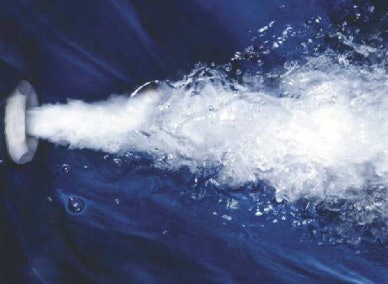
Consider the jet. Jets lead double lives, delivering all-important hydrotherapy and carrying more than their fair share of the marketing burden as well.
While some manufacturers are scrambling to differentiate their tubs from the pack by adding lights, televisions and sound systems, others are marketing with a medical focus and an emphasis on hydrotherapy. But whether the marketers push entertainment or therapy, it's the jets that are at the heart of the spa experience.
But how much do you — and your customers — know about jets? The right jets in the right configuration can make the difference between a warm relaxing soak (and there's nothing wrong with that) and a healing therapy session. The point is to figure out what the customer wants, and deliver it.
The Party's Over!
It's no secret that spas have come a very long way from the early days of redwood party tubs that looked more like a half whiskey barrel than a piece of therapy equipment. And while manufacturers continually tinker with the sizes and configurations of seating in the spa, it's the evolution of jets that has transformed spas from a glorified warm bath into the serious relaxation and therapy devices they've become today.
"When they first started making portable spas, there were only four or five jets per tub," says Patti Kirsch, vice president of Waterway, a manufacturer of products for the spa, pool and bathtub industry and a major supplier of portable spa jets. "Now there can be over a hundred, really." And among those 100 jets, there might be 20 different types and sizes.
Most jets for spas and bathtubs are made by a few large companies that specialize in this very specific type of plumbing fixture. They concentrate on innovations and improvements in function, aesthetics and ease of production. As the category's image has evolved from "party tub" to hydrotherapy, the need for increasingly specific and specialized types of jets has challenged the jet manufacturers.
"At the beginning, hot tubs were more of a party thing," says Kirsch. "Now, because more families are involved, the industry's gotten larger and there's more of a family focus. So I've noticed a lot of OEMs are really pushing hydrotherapy, and some of them are even doing studies now on arthritis and diabetes. So it's turned. It's become so much more mature than it was 20 years ago."
With spa manufacturers' marketing plans increasingly focused on family, the ability to deliver a variety of hydrotherapy experiences is a valuable commodity. Says David Carleton of Dimension One Spas, "If they're looking for hydrotherapy, they want one type of jet, if they're looking for relaxation, they might want a different type of jet. That's why a lot of manufacturers make their jets interchangeable. So if Mom wants hydrotherapy and Dad wants relaxation, they can switch them around."
The role that jets play in hydrotherapy is pretty easy to understand. "The whole idea of hydrotherapy is to produce the feeling of someone massaging your back and your neck," says Michael Kort, HydroAir's national sales manager. And manufacturers have developed a plethora of jets designed to do just that. "Spinning jets carry a different flow or pattern than eyeball jets, where water just comes shooting out of a hole. Normally an eyeball jet will deliver a harder massage than a moving jet."
And there's no rule that says one way is better than the other. Some consumers want to soak to relax away the day's cares. Others climb in the tub to work on stubborn athletic injuries. Still others want a massage that will relieve arthritis pain. And the type of jet that will knead the kinks out of a 35-year-old's softball pitching arm might deliver an uncomfortable assault to the 80-year-old who wants to soak away arthritis aches and pains. It's a matter of assessing the customers' needs and meeting them.
A Better Mousetrap
On the one hand, jets are very simple. They deliver water under pressure to the spa and the lucky person who is soaking in it. But industry research and development professionals have found myriad ways to deliver the water. According to several jet manufacturers, one big challenge today is to make a jet that spins but doesn't have a bearing.
"The bearingless jet is going to be really big," says Kirsch. "Cal Spas really started doing that just last year. Bearings have always kind of been a problem because they get calcium build-up and they freeze up and that's been a warrantee issue, so if you get the bearings out, then you don't have that."
At Pentair, the R&D folks have worked on shielding the bearings and developing an alternate spinning mechanism as well. "We've had a bearing that swirls in a lot of our jets for years, and some manufacturers feel that the bearings get loaded with debris that's inherent floating in water, and that that's an issue," says Ron Williams, the company's national sales director. "We made a major redesign of our jets about a year ago. We call it the low-clog design where the inside of the jet actually covers the bearing area so it's difficult to get debris to .ow through there. But lately there's been a push to create a jet style that doesn't have a bearing, that floats on a shaft or something."
HydroAir introduced a bearing-free spinner in the '80s, which fell out of favor because jets with bearings spun faster and harder. "We offered bearing jets because customers demanded it," says Kort. "Now it's come around full circle to where technology has improved the spinning capability without the use of a ball bearing. And that's the course that we've headed down over the last couple of years, and continue to do."
Second Job
While jets form the backbone of the hydrotherapy experience, they also play a major role (beyond their therapeutic virtues) in marketing the spa. "When we introduce new offerings, we're going to introduce a jet that is going to be more trouble free, because it won't have a ball bearing," says Kort. "That's warrantee marketing, not necessarily therapy marketing. If you have a ball bearing or you don't have a ball bearing, that's not necessarily saying that the massage in one is going to be better than the other."
What Do They Want?
Jets deliver hydrotherapy and the increasingly reliable, trouble-free models help enhance the warrantee. But they are also an important part of developing the brand and the personality of the spa.
"Each of the individual companies from large to small tries to market their way of delivering the water, which they say is better than somebody else's way," says Kort .
"They all do it differently," says Williams. "We supply a component, but then they take it and interpret it into their presentation to sell their product."
Whether it's the action of the jet, the size, the color or the materials it's made from, spa manufacturers want a unique jet that will enhance their brand and set them apart from the crowd.
"It kind of reflects what they are really going after. You can look at their product and you see it," says Williams. "They want it to look different. It's on the showroom floor with three or four other lines of therapy spas."
Kirsch agrees that providing jets that reinforce the manufacturers' brands and help sell the spa is a priority. "Most of them want their own story," she says. "The larger spa OEMs have to have their own identity and look, so that's been our key, because we've been able to make their own escutcheon look or their own eyeball, and usually it's a spinner or something because the consumer likes looking at that."
HydroAir also works to give its customers an edge in the marketing game. "We have customers who are partners and we may do cosmetic looks or maybe something in particular that they wouldn't want anyone else to have," says Kort.
While dealers are selling the function and the aesthetics and the reliability of their spas' jets to the consumer, jet manufacturers have one more thing to sell. "We're concentrating on the assembly processes more than anything, what happens on the back side," says Williams. Spas that can be assembled quickly account for less overhead. "The manufacturer is trying to preharness his plumbing assemblies, he's trying to come up with the fastest way that he can take all these 100 connections — you've got a connection for water and a connection for air — onto a production line and be able to put them on in no time at all."
Williams sums up the multi-tasking job of a jet succinctly. "The back side is really critical to the manufacturing process. The front side is critical to marketing and to the consumer and the dealer."
Help For The Indecisive
In the race to be unique, Bullfrog Spas may have the edge in the jet department for the moment. The young company, based in Sandy, Utah, manufactures a spa and JetPak system that allows users to change the jet modules at any time without draining the spa. "Our spa is molded with a pocket to accommodate the pack," says Steve Fleischer, vice president of product development. "The jets have to be off and the pump can't be running, but you just undo two union rings; a consumer can do it in about a minute. So right in the middle of your hot tub session, you can just unplug one, plug another one in and jump back in."
Fleischer points out that with the JetPak, in addition to variety, consumers can have the latest technology every year without buying an entirely new spa. "There's always something new that comes out," Fleischer says. "Our JetPaks are always being updated and improved, so someone who has a three- or five-year-old spa can just plug in the new pack and have the latest technology."
John Diaz of The Spa Gallery at Branchini's in Iowa City, Iowa, finds that his customers quickly develop an appreciation for the many different types of jets available — there are 18 different JetPaks. "They come in with not much of an education on the differences in jets. But when you look at a Bullfrog, there's a reason why you need to know about the different jets because you have such a choice."
Diaz says the ability to customize with the JetPaks helps him give customers exactly what they need. "We've got customers who have had specific injuries and need certain kinds of jets. There's one that actually pulls out like the sprayer on your kitchen sink. You can use that on specific joints or injury areas."











































